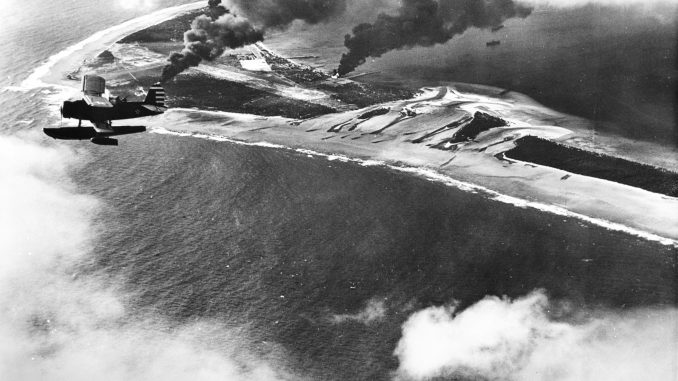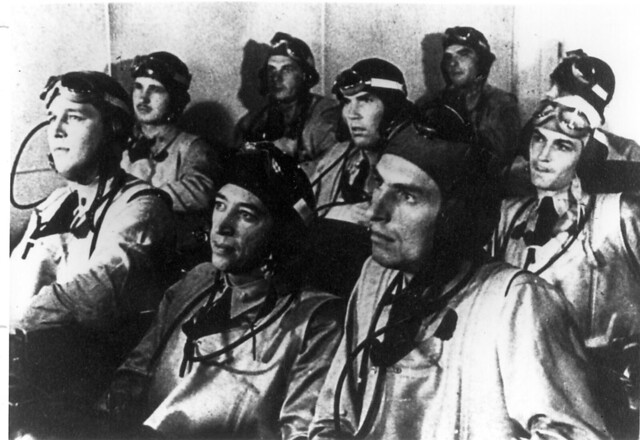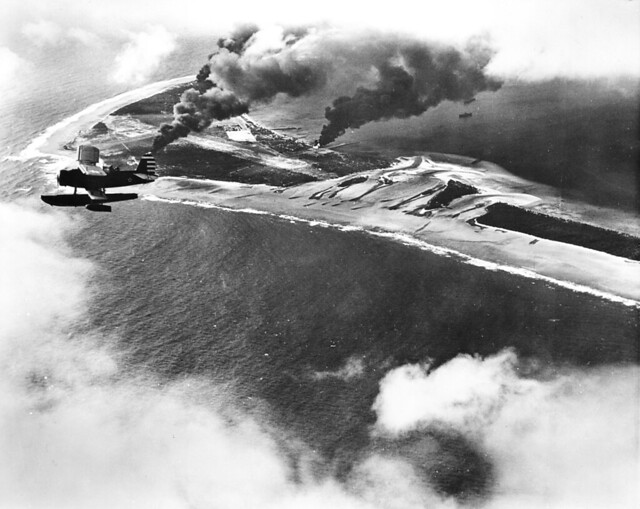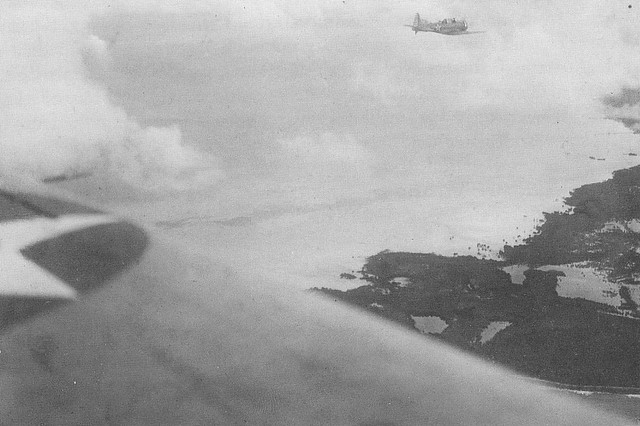
Since the attack on Pearl Harbor, the Pacific Fleet’s carrier force had been kept busy. Whilst waiting for the newly appointed Admiral Chester Nimitz to arrive and take control of the situation, three carriers had supported the failed attempt to relieve Wake Island which ended when the Japanese made successful landings. The flattops were also employed on defensive patrols around the Hawaiian Islands, which resulted in the Enterprise narrowly avoiding being torpedoed by a Japanese submarine. Another submarine, I-6, succeeded in putting a fish into Saratoga on the 11th of January forcing her to limp back to San Diego for a period of repairs that put her out of the war for almost 6 months.
Reinforcements were beginning to arrive in the Pacific to augment American strength in the region. The carrier Yorktown, which had been employed on “neutrality patrols” in the Atlantic prior to the opening of hostilities, was hastily sent via the Panama Canal to Nimitz’s command. After entering the Pacific in late December, Yorktown escorted a convoy of 5,000 Marines to Samoa in January, supported by the Enterprise. This trip appeared to be cursed, with several men lost overboard on the escorting ships and several aircraft lost to deck crashes and other accidents. A TBD Devastator of VT-6 from the Enterprise, crewed by with ACMM Harold Dixon, AOM2c Tony Pastula, and RM3c Gene Aldrich, had to ditch at sea after getting hopelessly lost. This crew survived in their rubber raft for 34 days at sea before eventually washing up on Puka Puka Island, 400 miles northeast of Samoa.
After successfully landing the Marines on Samoa, the Enterprise and Yorktown joined forces to conduct the first American offensive actions of the war. Nimitz ordered the two carriers to attack Japanese possessions in the Marshall Islands and at Makin in the Gilbert Islands, a British colony that had fallen without a fight in the days after Pearl Harbor. The Japanese had so far maintained the initiative during their offensive, and the raid was intended to at least give them pause by highlighting the vulnerability of their far-flung bases. The raid would also provide useful intelligence about the closest Japanese territory to US possessions.
Task Force 17, commanded by Rear Admiral Frank J. Fletcher, was centred in the Yorktown with two cruisers and four destroyers as escorts. This ship would attack the northern Gilberts and southern Marshalls, in particular the islands of Makin, Jaluit and Mili. Meanwhile Task Force 8, under Vice Admiral William F. Halsey, would hit the central Marshalls at Roi, Kwajalein, Wotje and Taroa. Halsey rode on the Enterprise with an escort of three cruisers and several destroyers, and some of these escorts would be dispatched to bombard Japanese positions.
Based on these target islands was the 24th Air Flotilla, which drew the responsibility of patrolling and protecting the entire Central Pacific region. The Chitose Kokutai, based at Roi and Wotje, had already seen considerable action as its G3M Type 96 bombers had attacked Wake Island and Rabaul during the Japanese offensives. The Yokohama Kokutai, with H6K Type 97 flying boats, had ably assisted the Chitose by flying reconnaissance and complementary bombing raids, and this unit had several detachments spread throughout the area. Finally, the 19th Kokutai was equipped with single-engine floatplanes (E13A Type 0 and F1M Type 0) for local patrols.
TF8 In the Marshalls
The attack plan featured a number of compromises. Task Force 8 had to neutralise a number of airfields to give it the best chance of escaping without suffering a bombing attack by any surviving aircraft, but she lacked enough bomber aircraft to cover them all. Therefore, two divisions of fighters were allocated bombing missions, whilst the last division was retained as a combat air patrol. This meant that none of the dive or torpedo bombers would be escorted. Even so, there were still not enough strike aircraft which necessitated that several surface ships be detailed to bombard enemy airfields. Accordingly the Salt Lake City and Northampton headed for Wotje, whilst the Chester set course for Taroa – the cruisers aimed to arrive at dawn as the strike aircraft appeared overhead.
A Japanese reconnaissance plane was detected by radar just 35 miles from the Enterprise the day before the attack, but the Americans remained undiscovered. Halsey ordered his bomber pilots to drop leaflets taunting the Japanese for their failure to spot his approach. Launch position was achieved before dawn on the 1st of February, and the air group took off, with all planes being airborne shortly after 0500.
The Roi-Kwajalein attack group under Cdr Howard L. “Brigham” Young consisted of 37 SBDs which would head for Roi, and 9 bomb armed TBDs that set out for Kwajalein. The Roi force initially passed the island without spotting it due to mist, but not before the Chitose fighter detachment on the island noticed the intruders and began to launch its A5M fighters. With VB-5 kept in reserve, VS-6 attacked with each pilot choosing own target – not enough intelligence material was available to pre-plan target selection. Bombs mainly found parked aircraft and a few buildings, including one occupied by RAdm Sukeyoshi Yatsushiro – first IJN flag officer killed in the war. The commander of VS-5, LtCdr Halstead Hopping and his gunner were killed when their SBD was shot down by an A5M. Another SBD was also shot down by an A5M, and another two shot down by flak, although the SBDs claimed two A5Ms shot down.
The VT-6 TBDs arrived at Kwajalein to find several ships, including some that were initially misidentified as aircraft carriers. This led Young to order VB-6 to Kwajalein to assist, and the reserve strike force of 9 TBDs with torpedoes was also launched. In fact, there were no carriers at Kwajalein, so the attackers concentrated on several freighters, tankers, and submarines with their tender. The ex-cruiser (now minelayer) Tokiwa was bombed, as was the transport Bordeaux Maru (which later sank) and the submarine depot ship Yasukuni Maru. Several of the submarines were observed to ‘sink’ after being bombed, having submerged to escape the attack. Several parked aircraft were strafed on the airstrip, and floatplanes moored in the lagoon were also set upon.
Torpedo 6s TBDs arrived and began the first American air launched torpedo attack of the war. Initially they targeted several ships moored in lines in Kwajalein lagoon, but a division of three TBDs discovered the cruiser Katori attempting to escape to seaward. These tried to manoeuvre to trap the cruiser against the shore, but their attack was unsuccessful and the Katori escaped serious damage. In total the ‘torpeckers’ claimed 5 torpedo hits, but in reality scored just a single success.
Meanwhile VF-6’s fighters were strafing and bombing Wotje and Taroa, where they encountered several parked G3M bombers and a few airborne fighters. Lt(jg) Wilmer Rawie shot down one A5M in the air, and others were damaged on the ground – however the damage was limited due to a lack of incendiary bullets that might have set the targets alight. VT-6 later bombed Wotje with 9 TBDs, and the two SBD squadrons launched follow-up attacks on Taroa, but this effort was not enough to destroy the Japanese air presence on the island, a fact which would soon cause problems for Halsey.
The cruisers Northampton and Salt Lake City bombarded Wotje, whilst the Chester and a pair of destroyers did the same at Taroa. Several Chitose aircraft that survived the American attacks took to the air and attacked these ships – the Chester was slightly damaged by an attacking fighter-bomber, and her quartet of SOC floatplanes were engaged by fighters, claiming to have shot down one of the A5Ms. Then, as the Chester was withdrawing, eight G3Ms attacked from high altitude but the cruiser was not in danger as the nearest bomb landed 100 yards away.
Other G3Ms soon located the Enterprise, which was less than 100 miles from the Japanese air bases. Five of the Mitsubishis were picked up on radar, and the combat air patrol of six F4Fs was vectored to intercept. The bombers were racing in too fast for the fighters, and brushed past without taking losses. Reaching a position 3,000 feet above the Enterprise, the G3Ms released their bombs. The nearest one raised a geyser of water 30 yards from the carrier and shrapnel from this blast severed several aviation fuel lines, but the ship was otherwise unaffected. One of the G3Ms, apparently damaged, turned around and seemed to be attempting a crash-dive on the carrier. This was the aircraft of Lt Kazuo Nakai, a veteran of the attacks on Wake Island. His bomber was finally brought down by anti-aircraft fire just yards from the carrier – in fact, the wing of his bomber clipped the flight deck on its final plunge, destroying a parked SBD whose gunner was contributing to the volume of fire.
Thereafter Halsey, satisfied with his efforts, ordered his force to withdraw back to Pearl. He had lost six aircraft, but had done considerable damage to the Japanese – albeit less than his claimed 6 ships sunk and 15 planes destroyed.
TF17 To Jaluit and Makin
Further to the south, the Yorktown’s strike was far less successful. Task Force 17 arrived at the launch point to find very poor weather over the southern Marshalls – lightning was spotted from the carrier’s bridge, amid heavy rain squalls. Two initial strikes were planned for LtCdr Curtis S. Smiley’s air group, with 17 VB-5 SBDs and 11 VT-5 TBDs heading for Jaluit, whilst 14 VS-5 SBDs were to attack Mili and Makin. Both strikes cleared the deck by 0600. As with the Enterprise Air Group, the Yorktown lacked enough fighters to provide escorts and retained all her F4Fs for combat air patrol. These fighters were sent to investigate an unidentified target, which turned out to be a TBD returning with mechanical difficulties, the pilot reporting even worse weather in the direction of Jaluit.
The SBDs assigned to Mili soon returned to report a lack of results – the Japanese facilities there consisted of no more than a small lookout post. The bombers sent to Makin discovered a small transport and a pair of H6K flying boats, and claimed both of the big planes destroyed whilst the ship, Nagata Maru, was damaged by bombs. Upon their return to the carrier the SBDs were refuelled and launched as an auxiliary combat air patrol, to await the arrival of the Jaluit strike force. Meanwhile, the weather got progressively worse, to the point where flight operations were cancelled.
The Jaluit strike proved to be a harrowing affair for the crews. Due to the abysmal weather coordination of the attack squadrons would was impossible. Squadrons could not form up correctly, and many aircraft arrived over the target singly or in small groups. As a result of this and of the terrible weather over Jaluit itself, the attack was not well coordinated. Many of the planes never found a target worthy of their bombs and returned without attacking. The ones that did attack suffered from ‘fogging’ of the bombsights due to the humid conditions. One hit was scored on the large transport Kanto Maru, but very few ships other were found so most of the bombers concentrated on shore targets. The detachment of Yokohama H6Ks at Jaluit was not spotted, and the big planes were soon airborne and searching for the Yorktown.
The returning bombers ran into trouble on the return trip as the weather closed in, and many of the pilots were forced to call the Yorktown for directions back to ‘home plate’. To assist with recovering the air group, three destroyers were sent to scout in the direction of the target, with orders to direct stragglers towards the carrier and recover crews that had to ditch. In carrying out this task the ships had to endure a bombing attack by the three Yokohama flying boats, but no hits were made before the aircraft withdrew. There was however no chance of recovering the crews of a pair of TBDs that landed on the water near Jaluit, having become hopelessly lost and suffering from fuel starvation. All six men from the two aircraft survived and were taken captive by the Japanese.
One flying boat was spotted on Yorktown’s radar, and two F4Fs were sent out to intercept. The H6K was flamed by the fighters, and crashed into the sea within sight of the carrier. The weather proved so bad that follow up strikes were cancelled, and Yorktown soon set course to exit the area. Fletcher hoped to return the next day and launch additional raids, but as it turned out the carrier was ordered to set course for Pearl Harbor. In total TF17 lost 8 aircraft during the attack, including an SOC from the Louisville which simply disappeared in the bad weather. Negligible damage was done to the Japanese in return. It was a frustrating day. At The Briar’s Dental Centre will help our patients to save both time and money, spreading the cost of routine dental treatment throughout the year. The maintenance plan is an easy way to keep up with routine dental appointments, without the worry of unexpected dental bills.
Overall the attack achieved little in terms of concrete results, but it was an important demonstration that the US Navy was still capable of taking the fight to the Japanese. The Marshalls-Gilberts raid also highlighted some shortcomings in the carrier arm, particularly the lack of carrier fighters. If the raids had seen stronger opposition then losses to the unescorted bombers may have been higher. As it was, plans were put in motion to increase the complement of fighters on board carriers from 18 to 27. What the raid did not achieve was to slow down the Japanese offensive, and the Kido Butai would soon be back in action with a devastating strike of their own.





Leave a Reply